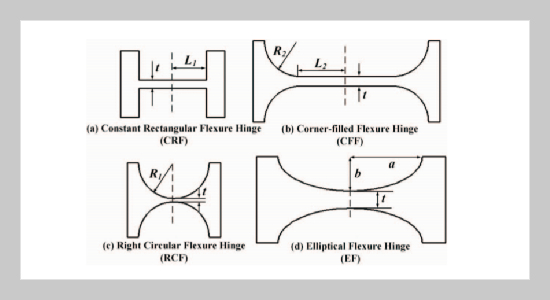REFERENCES
- [1] Xu, Q. S., “Design, Testing and Precision Control of a Novel Long-stroke Flexure Micro-positioning System,” Mechanism and Machine Theory, Vol. 70, No. 6, pp. 209�224 (2013). doi: 10.1016/j.mechmachtheory.2013. 07.016
- [2] Li, Q. X., Wang, D. S., Li, Y. H., Design of Modern Precision Instruments, Tsinghua University Press, Beijing, pp. 156�162 (2004).
- [3] Zhang, D., Gao, Z., Malosio, M., et al., “ANovel Flexure Parallel Micromanipulator Based on Multi-level Displacement Amplifier with/without Symmetrical Design,” International Journal of Mechanics and Materials in Design, Vol. 8, No. 4, pp. 311�325 (2012). doi: 10. 1007/s10999-012-9197-3
- [4] Bhagat, U., Shirinzadeh, B., Clark, L., et al., “Design and Analysis of a Novel Flexure-based 3-DOF Mechanism,” Mechanism and Machine Theory, Vol. 74, No. 4, pp. 173�187 (2014). doi: 10.1016/j.mechmach theory.2013.12.006
- [5] Choi, S. B., Han, S. S., Han, Y. M., et al., “A Magnification Device for Precision Mechanisms Featuring Piezoactuators and Flexure Hinges: Design and Experimental Validation,” Mechanism and Machine Theory, Vol. 42, No. 9, pp. 1184�1198 (2007). doi: 10.1016/j. mechmachtheory.2006.08.009
- [6] Do, T. N., Tjahjowidodo, T., Lau, M. W. S., et al., “Hysteresis Modeling and Position Control of Tendonsheath Mechanism in Flexible Endoscopic Systems,” Mechatronics, Vol. 24, No. 1, pp. 12�22 (2014). doi: 10.1016/j.mechatronics.2013.11.003
- [7] Meng, Q. L., Li, Y. M. and Xu, J., “A Novel Analytical Model for Flexure-based Proportion Compliant Mechanisms,” Precision Engineering, Vol. 38, No. 3, pp. 449�457 (2014). doi: 10.1016/j.precisioneng.2013.12. 001
- [8] Kim, J. J., Choi, Y. M., Ahn, D., et al., “A Millimeterrange Flexure-based Nano-positioning Stage Using a Self-guided Displacement Amplification Mechanism,” Mechanism and Machine Theory, Vol. 50, No. 2, pp. 109�120 (2012). doi: 10.1016/j.mechmachtheory.2011. 11.012
- [9] Bi, S. S., Zhao, S. S. and Zhao, X. F., “Dimensionless Design Graphs for Three Types of Annulus-shaped Flexure Hinges,” Precision Engineering, Vol. 34, No. 3, pp. 659�666 (2013). doi: 10.1016/j.precisioneng.2010. 01.002
- [10] Lobontiu, N., “Compliance-based Matrix Method for Modeling the Quasi-Static Response of Planar Serial Flexure-hinge Mechanisms,” Precision Engineering, Vol. 38, No. 3, pp. 639�650 (2014). doi: 10.1016/j. precisioneng.2014.02.014
- [11] Lobontiu, N. and Cullin, M., “In-plane Elastic Response of Two-segment Circular-axis Symmetric Notch Flexure Hinges: the Right Circular Design,” Precision Engineering, Vol. 37, No. 3, pp. 542�555 (2013). doi: 10.1016/j.precisioneng.2012.12.007
- [12] Bolzmacher, C., Bauer, K., Schmid, U., et al., “Displacement Amplification of Piezoelectric Microactuators with a Micromachined Leverage Unit,” Sensors and Actuators A: Physical, Vol. 157, No. 1, pp. 61�67 (2010). doi: 10.1016/j.sna.2009.10.014
- [13] Ma, H. W., Yao, S. M., Wang, L. Q., et al., “Analysis of the Displacement Amplification Ratio of Bridge-type Flexure Hinge,” Sensors and Actuators A: Physical, Vol. 132, No. 6, pp. 730�736 (2006). doi: 10.1016/j. sna.2005.12.028
- [14] Xu, Q. S. and Li, Y. M., “Analytical Modeling, Optimization and Testing of a Compound Bridge-type Compliant Displacement Amplifier,” Mechanism and Machine Theory, Vol. 46, No. 2, pp. 183�200 (2011). doi: 10.1016/j.mechmachtheory.2010.09.007
- [15] Choi, K. B., Lee, J. J. and Hata, S., “A Piezo-driven Compliant Stage with Double Mechanical Amplification Mechanisms Arranged in Parallel,” Sensors and Actuators A: Physical, Vol. 161, No. 1�2, pp. 173�181 (2010). doi: 10.1016/j.sna.2010.05.027
- [16] Yu, Y. Q., Feng, Z. L. and Xu, Q. P., “A Pseudorigid-body 2R Model of Flexural Beam in Compliant Mechanisms,” Mechanism and Machine Theory, Vol. 55, No. 9, pp. 18�33 (2012). doi: 10.1016/j.mechma chtheory.2012.04.005
- [17] Yu, Z. Y., Yao, X. X. and Song, X. D., “Design of Micro-displacement Amplifier Based on Flexure Hinges,” Chinese Journal of Scientific Instrument, Vol. 30, No. 9, pp. 1818�1822 (2009).
- [18] Zhao, L., Gong, Y. and Hua, Y. Y., “Compliance Matrix Analysis of Corner-filleted Flexure Hinge,” China Mechanical Engineering, Vol. 24, No. 18, pp. 2462� 2468 (2013).
- [19] Tian, Y., Shirinzadeh, B., Zhang, D., et al., “Three Flexure Hinges for Compliant Mechanism Designs Based on Dimensionless Graph Analysis,” Precision Engineering, Vol. 34, No. 1, pp. 92�100 (2010). doi: 10. 1016/j.precisioneng.2009.03.004
- [20] Lu, Q., Cui, Z. and Chen, X. F., “Fuzzy Multi-objective Optimization for Movement Performance of Deep-notch Elliptical Flexure Hinges,” Review of Scientific Instrument, Vol. 86, No. 6 (2015). doi: 10.1063/1.4922914
- [21] Zhao, L., Gong, Y. and Hua, Y. Y., “Compliance Matrix Analysis of Corner-filleted Flexure Hinge,” China Mechanical Engineering, Vol. 24, No. 18, pp. 2462� 2468 (2013).
- [22] Zuo, X. Y. and Liu, X. M., “Calculation and Analysis of Rotational Stiffness for Three Types of Flexure Hinges,” Chinese Journal of Scientific Instrument, Vol. 27, No. 12, pp. 1725�1728 (2006).
- [23] Zhao, H. W., Wu, B. D. and Cao, D. B., “Mechanical Performance of Right-Angle Flexure Hinge,” Nanotechnology and Precision Engineering, Vol. 5, No. 2, pp. 143�147 (2007).
















